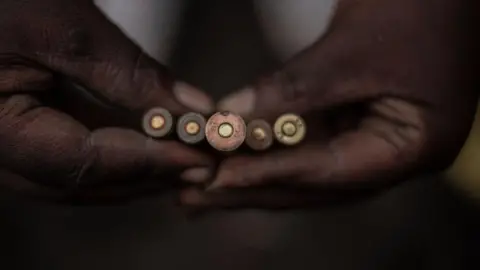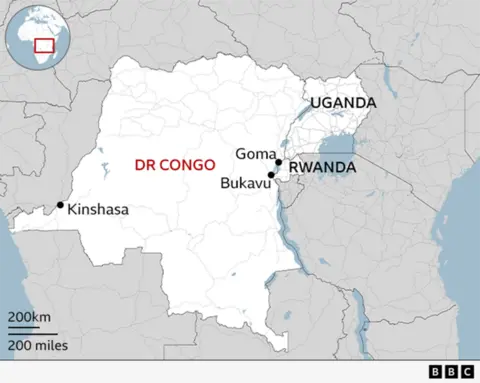What's the fighting in DR Congo all about?
 AFP
AFPThe mineral-rich east of the Democratic Republic of Congo has been dogged by conflict for more than 30 years, since the 1994 Rwandan genocide.
Numerous armed groups have competed with the central authorities for power and control of the potential fortune in this vast nation.
The instability has sucked in neighbouring countries to devastating effect – notoriously in the 1990s when two huge conflicts, dubbed Africa's World Wars, resulted in the deaths of millions of people.
Fighting escalated again earlier this year when a rebel group known as the M23 made major advances across the east. At the end of June, the US brokered a peace deal in an attempt to halt the conflict.
What has the M23 done?
In a rapid advance, the M23 captured a number of key cities and towns.
The group's first major coup was at the end of January with the taking of Goma – a city in North Kivu province that is home to more than a million people.
Sitting on the border with Rwanda and the shores of Lake Kivu, Goma is a vital trading and transport hub that is within reach of mining towns supplying metals and minerals in high demand.
In February, the M23 also seized another important city in the region, South Kivu provincial capital Bukavu.
Fighting between the M23 and the Congolese army and allied militia has continued in the region as the rebels attempt to expand their territory.
Thousands of people have been killed in the conflict, while many more have been forced from their homes.
At one point, the M23 threatened to target the nation's capital, Kinshasa - a city 2,600km (1,600 miles) away, on the other side of this vast country.
Who are the M23?
The M23 is led by ethnic Tutsis, who say they needed to take up arms to protect the rights of the minority group.
They say that several previous deals to end decades of fighting in the region have not been respected - they take their name from a peace agreement that was signed with a previous Tutsi-led rebel group on 23 March 2009.
Shortly after its creation in 2012, the M23 rapidly gained territory and seized Goma – acts that were met with international opprobrium and accusations of war crimes and human rights violations.
It was forced to withdraw from Goma, and then suffered a series of heavy defeats at the hands of the Congolese army along with a UN force that saw it expelled from the country.
M23 fighters then agreed to be integrated into the army in return for promises that Tutsis would be protected.
But, in 2021, the group took up arms again, saying the promises had been broken.
Is Rwanda involved in the fighting?
On 27 June, DR Congo signed a peace deal in Washington in an attempt to halt the conflict.
The agreement was signed not with the M23 - whose armed forces have occupied huge areas of the region - but with Rwanda, DR Congo's neighbour.
There is overwhelming evidence that Rwanda is backing the M23.
Last year a group of UN experts said that up to 4,000 Rwandan troops were fighting alongside the rebels. They also said the Rwandan army was in "de facto control of M23 operations".
DR Congo, US, the UK and France also say Rwanda is supporting the M23.
While M23 leader Sultani Makenga is a Congolese Tutsi who previously fought in the Rwandan army.
The government in Rwanda's capital, Kigali, denies providing financial or military support to the M23. They say they have taken defensive measures to protect Rwandan territory.
By signing the Washington peace deal, it become even more difficult for Rwanda to deny that it is involved in the conflict.
What is the connection with Rwanda?
The origin of the current fighting can partly be traced back to the genocide in Rwanda in 1994.
About 800,000 people – mostly from the Tutsi community - were slaughtered by ethnic Hutu extremists.
The genocide ended with the advance of a force of Tutsi-led rebels commanded by Paul Kagame, who is now president.
Fearing reprisals, an estimated one million Hutus then fled across the border to what is now DR Congo. This stoked ethnic tensions as a marginalised Tutsi group in the east – the Banyamulenge – felt increasingly under threat.
Rwanda's army twice invaded DR Congo, saying it was going after some of those responsible for the genocide, and worked with members of the Banyamulenge and other armed groups.
After 30 years of conflict, one of the Hutu groups, the Democratic Forces for the Liberation of Rwanda (FDLR), which includes some of those responsible for the Rwandan genocide, is still active in eastern DR Congo.
Rwanda describes the FDLR as a "genocidal militia" and says its continued existence in the DR Congo's east threatens its own territory. In February, Rwandan government spokesperson Yolande Makolo told the BBC the FDLR wanted to return to Rwanda to "finish the job", and this is why Rwanda had to defend its territory.
Rwanda accuses the Congolese authorities of working with the FDLR.
DR Congo denies this, but in the recent peace deal, both sides agreed to ending "state support" for the FDLR. The agreement also says the group should be neutralised and Rwanda should row back on its "defensive measure".
What does the DR Congo peace deal say?
The agreement drawn up by the US hopes to succeed where multiple others have failed.
The deal demands that:
- Rwanda "disengage" its forces
- Both countries refrain from supporting armed groups and instead facilitate their "disengagement, disarmament and integration"
- Both countries refrain from acts of aggression
However, the absence from the deal of the M23 - the most prominent armed group in the conflict - has drawn criticism.
Many have also noted that the agreement does not state whether the M23 will withdraw from all the territory in eastern DR Congo that it now occupies.
Although the M23 did not sign the Washington deal, they are engaged in separate peace talks with the Congolese government, mediated by Qatar.
The deal signed in Washington also has an economic dimension - that potentially grants the US lucrative access to the region's mineral wealth.
Rwanda and DR Congo should work to "expand foreign trade and investment" in "critical mineral supply chains", the agreement says.
The government in Kinshasa reportedly offered the US access to critical minerals in exchange for security guarantees earlier this year after losing territory to the M23.
What about Congo's mineral wealth?
DR Congo and multiple UN reports have accused Rwanda of using the conflict as a way of looting Congolese minerals, such as gold and coltan, which is used to make mobile phones and other electronic items such as cameras and inside cars.
In recent years, the M23 has seized several lucrative mining areas and a report by UN experts last December said that around 120 tonnes of coltan was being sent by the M23 to Rwanda every four weeks.
Rwanda has consistently denied allegations of exploiting DR Congo's minerals.
What are the UN peacekeepers doing?
A UN peacekeeping mission has been in place since 1999. The current force – known as Monusco – is made up of more than 10,000 troops.
However, of these, only the Force Intervention Brigade is allowed to carry out offensive operations against armed groups. It was this force that helped defeat the M23 in 2013.
Monusco has been the target of anger from ordinary Congolese who see it as failing to do its job. President Tshisekedi, deeming the mission a failure, had asked it to leave by the end of last year.
But the departure was delayed and in December the mission was extended for another year.
A military force from Southern African Development Community (Sadc), a regional grouping of 16 countries, that was deployed in late 2023 began withdrawing at the end of April.
It had failed to halt the M23 advance and in March its mission was terminated.
This came after 14 South African soldiers were killed in January, along with several more from Malawi and Tanzania.

More about the conflict in DR Congo:
 Getty Images/BBC
Getty Images/BBCGo to BBCAfrica.com for more news from the African continent.
Follow us on Twitter @BBCAfrica, on Facebook at BBC Africa or on Instagram at bbcafrica
